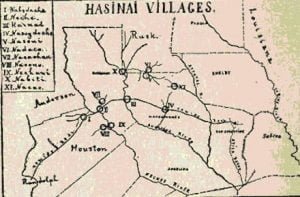The Neche Tribe and the Mission of San Francisco
Southwest of the Hainai village, nearly straight west of the Nacogdoche, was the Neche village, near the east bank of the Neches River, and near the crossing of the Camino Real. The diaries usually represent the distance from the Neche to the Hainai as about the same as that from the Hainai to the Nacogdoche some eight or nine leagues. The air line distance was evidently somewhat less in the former case than in the latter, but the route was less direct, since between the Neches and the Angelina Rivers the road bowed quite decidedly to the north. The usual crossing of this … Read more

